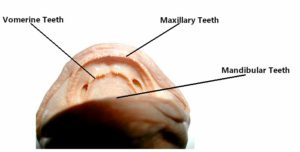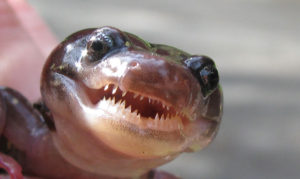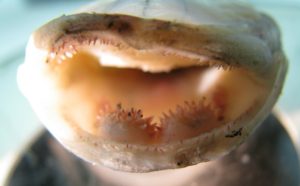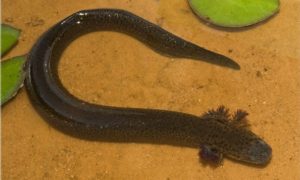Salamanders are intriguing creatures that attract the curiosity of many people. They also tend to be very secretive, so they are not frequently encountered most times of the year. Because of this, there are many misconceptions about these beautiful animals.
Most salamander species have tiny teeth in both their upper and lower jaws. However, arboreal salamanders (a type of climbing salamander), have especially large well-developed teeth that are also very sharp.
Salamanders are different from other amphibians because even their larvae (baby salamanders) have teeth.
That said, it is important to note that salamanders do not use their teeth to chew their food as we do. Rather, their teeth are used to hold onto prey as they swallow it whole, very similar to how lizards use their teeth.
Most Salamanders Only Have Very Tiny Teeth
The majority of salamanders have very tiny teeth that are barely even noticeable. While mammals have teeth dedicated to specific functions (such as canines to rip apart food, incisors to bite, and molars to grind), salamanders do not. Their teeth are fairly uniform and do not specialize. As mentioned earlier, their function is to grip rather than to bite or chew.
Salamanders Have 5 Types of Teeth
In general, salamanders have 5 types of teeth: Maxillary teeth, Premaxillary teeth, vomerine teeth, Palatal teeth, and Mandibular teeth.

Maxillary Teeth
Maxillary teeth refer to the teeth in the upper jaw, just like the teeth in our own upper jaws. In salamanders, these teeth look like little cones lining the edge of the upper jaw and are fairly uniform in size.
Since the maxillary teeth have a conical shape, they can not chew or tear apart food. They only help clutch onto the prey as the salamander swallows it whole.
Premaxillary Teeth
Premaxillary teeth are on the very edge of the upper jaw, right in front of the maxillary teeth. In most salamander species, they are only very slightly separated from the maxillary teeth.
In many cases, they are shaped and look just like the maxillary teeth, so it can sometimes be difficult to distinguish them.
Vomerine Teeth
These are called “vomerine teeth” because they are found in the facial bone called the vomer. The vomerine teeth are usually organized in tiny clusters on the roof of the salamander’s mouth, right behind the maxillary teeth.
Since these teeth are on the roof of the mouth, they cannot be seen unless the salamander’s mouth is carefully examined. Even then, they are so tiny that you most likely won’t even notice them without using a microscope.
They are most visible (to the naked eye) on the larger salamander species, such as the hellbender or the Chinese and Japanese giant salamanders.
Palatal Teeth
Like vomerine teeth, palatal teeth are also on the roof of the salamander’s mouth. They are usually right next to the vomerine teeth and are sometimes very difficult to distinguish from them. Because of this, they are occasionally just grouped with the vomerine teeth and referred to as “vomero-palatal” teeth.
Mandibular Teeth
Mandibular teeth refer to the teeth on the lower jaw (the mandible). These are the same as maxillary teeth, only that they are on the bottom, rather than the upper jaw
Along with the maxillary, premaxillary, vomerine, and palatal teeth, they maintain a firm grip on prey while the salamander swallows it whole.
Arboreal Salamanders Have Large Well-Developed Teeth
While most salamanders only have tiny teeth, arboreal salamanders have well-developed sharp teeth that are very large in proportion to the rest of their body. They also have very strong jaws and are capable of delivering a painful bite that can draw blood.
Male arboreal salamanders have broad triangular heads and teeth that are typically larger than those of females.

Arboreal salamanders are native to California and Baja California where they are often found on mossy rocks, and inside tree stumps in oak woodlands.
These salamanders have an ability that is unique among salamanders; they can climb trees! Arboreal literally translates to “living in trees”, and these salamanders live up to that name.
They are excellent climbers and have enlarged toe tips and a prehensile tail (a tail capable of grasping), to help them with this.
Larval Salamanders Have Teeth Different From Those of Adult Salamanders
Most salamanders develop in three distinct life stages: Egg, larvae, adult.
Female salamanders lay eggs in breeding ponds. A few weeks later, tiny aquatic larvae hatch from these eggs. The larvae live entirely in the water, just like frog tadpoles.
After a few months, the larvae will go through a process known as metamorphosis and transform into the adult salamanders you are more familiar with.
Since larval salamanders live in an aquatic environment and eat different food from the adults, their teeth are slightly different from those of the adults.
The teeth of the adult salamanders are usually slightly curved backward to more efficiently clutch onto prey. However, those of the larvae simply look like downward pointed cones.
Some Salamanders Have “Fangs”
Sometimes, larval salamanders can “shape-shift” and turn into cannibalistic morphs with wider heads and sharper recurved teeth. Their vomerine teeth also become more pronounced, enabling them to eat larger prey, including other larval salamanders.

This cannibalistic morph usually occurs when the larvae are in a water body with high competition for food. The wider mouths and fangs help them eat other larval salamanders.
It can also happen when the salamander larvae are in a temporal body of water, making it necessary for them to eat lots of protein so they can grow faster and get out of the water before it dries up.
Sirens Have Bony Ridges in Addition to Teeth
Sirens (a type of aquatic salamander) occasionally have bony ridges in place of the maxillary and mandibular teeth. Sometimes, they have these ridges in addition to the teeth.

Sirens are also the only salamander species known to eat plant matter (algae) in addition to prey. Scientists used to think this plant matter was accidentally ingested when the salamander ate or captured prey.
However, a study of their digestive systems showed that their intestines are similar to those found in herbivorous fish.
The bony ridges (rather than the maxillary and mandibular teeth), may help sirens eat algae more efficiently.
Frequently Asked Questions:
Question: Do Salamanders Bite?
Answer: If an animal has a mouth (and teeth), it most likely can bite to defend itself. Salamanders are known to bite, but they are generally very docile creatures that will rarely ever bite a human.
Since the majority of salamanders only have tiny teeth, a bite from a salamander usually won’t cause any serious harm, as the tiny teeth are unlikely to even penetrate your skin.
However, arboreal salamanders, given their sharp teeth and powerful jaws are capable of delving a painful bite. Their bites have been known to draw blood.
Check out this post for more thorough information on this topic.
Question: How Many Teeth Do Salamanders Have?
Answer: There are over 600 salamander species that are all somewhat different from each other. Because of this, there is no “one size fits all” answer to this question.
However, hellbender salamanders have about 162 teeth, La Palma salamanders have about 130 teeth, male two-lined salamanders have about 60 teeth, and female two-lined salamanders have about 67 teeth.
Question: Do Salamanders Lose Their Teeth?
Answer: Salamanders regularly lose their teeth, and they are quickly replaced by others. In two-lined salamanders, males will typically lose their premaxillary teeth when the breeding season ends, and new replacement teeth quickly grow in their place.
Final Thoughts
The majority of salamanders have very tiny teeth that work to grip onto prey rather than chew. Since there are so many salamander species, the exact type of teeth a salamander will have will depend on the species.
Some salamanders will have vomerine and premaxillary teeth, while others won’t. Other salamanders will have premaxillary teeth, but no vomerine teeth.
Arboreal salamanders are unique in that they have especially large very sharp teeth (and strong jaws), that they can use to deliver a painful bite.
Now you know all about salamander teeth!


